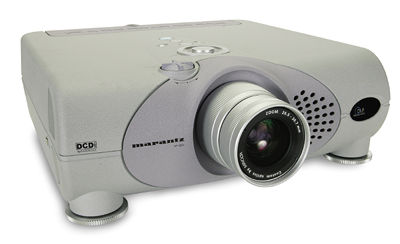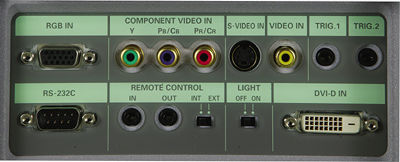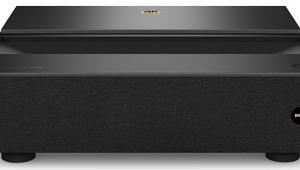Marantz VP-12S2 DLP projector
Marantz's VP-12S2, the company's top-of-the-line one-chip DLP projector, has a native resolution of 1,280:720 and utilizes the latest Texas Instruments HD2 Digital Micromirror Device (DMD) chip. This new chip offers a significant increase in contrast ratio and black-level performance over last year's VP-12S1 model. The VP-12S2's video processing also incorporates Faroudja's proprietary DCDi deinterlacing for video-based sources and 3:2 pulldown for film-based material. In fact, Marantz uses the full Faroudja chipset, which includes the video decoder, the video enhancer, the 2D comb filter, and DCDi. The latest Marantz DLP offering is definitely one of the top performers in its category.

The VP-12S2's design, look, and feel are identical to those of the VP-12S1 (October 2002). An attractive, sporty, industrial design complements the gray metallic finish. The projector is a compact, slim-lined design that measures 15.94 inches wide by 18.56 deep by 6.125 high and weighs a hefty 28.6 pounds. The build quality is exceptional. The remote is also identical to the one that comes with the VP-12S1, and it leaves a lot to be desired. It's extremely small and not backlit, making it a real chore to use in the dark. Although all of the buttons are illuminated, it's impossible to discern the function names, with the exception of the left, right, up, and down arrow keys. On the upside, you can access all of the inputs, picture modes, and aspect ratios from the remote. The commands are fully discrete, which makes it easy to program them into a Crestron- or AMX-type touchpanel remote system.
The VP-12S2's connectivity options aren't as comprehensive as I'd like. The projector sports one 15-pin VGA-style RGB input; only one broadband component video input (I'd prefer two); one S-video input; one composite video input; one RS-232 control port for use with a Crestron or AMX touchpanel control system; one DVI input with HDCP for use with new-generation HDTV set-top boxes with DVI outputs; two 12-volt trigger inputs for electric-drop and electric-masking screens; and a remote input and output. I set up the projector using the RGB input for my Dish Network HDTV source and the component video input for my Panasonic DVD-RP91 DVD player. The back panel can be fully backlit, which is convenient for making connections in a darkened home theater environment.
The VP-12S2 has several picture-enhancing features that are worth mentioning. In addition to the now-almost-obligatory 3:2 pulldown for film-based video sources, the video processing has Faroudja's DCDi deinterlacing circuitry for video-based material, which makes for exceptionally clean, smooth images for both film- and video-based NTSC sources. There are three selectable color temperatures: low, middle, and high. Out of the box, the middle setting comes closest to the NTSC standard of D6500, while the low setting is warmer (or redder), and the high setting lends a distinctly blue cast to the picture. The selectable aspect ratios include full for anamorphic DVD and HDTV sources, normal (4:3) for analog NTSC sources, and zoom for letterboxed nonanamorphic sources, such as the occasional widescreen broadcast over a cable or satellite system. There are four picture modes: theater, dynamic, standard, and user. Each mode has a total of three memory settings, which gives you the ability to customize your picture settings for any conceivable combination of video sources.
The VP-12S2 has a vertical-lens-shift feature that gives you a great deal of flexibility in the vertical placement of the projector relative to the screen. Although the projector offers both vertical and horizontal keystone correction, using these adjustments will degrade picture quality. When you use keystone correction on a fixed-pixel display, it cuts off pixels, thereby lowering the image's overall resolution. It also distorts the light path. The lamp is a 150-watt super high pressure (SHP) type with a rated life expectancy of 2,000 hours and a light-output rating of 700 ANSI lumens. I was very pleased to find that the VP-12S2, unlike its predecessor, has a full complement of gray-scale adjustments in the user menu's Fine Menu section.

The projector came from the factory with the contrast set at 50 percent, which produced a light output of 12 foot-lamberts. At the middle color-temperature setting, 20 IRE measured 6,185 Kelvin, and 80 IRE measured 6,220 K. After calibration, the VP-12S2's gray scale measured a near-perfect 6,460 K at 20 IRE and 6,460 K at 80 IRE. After calibration, the light output was 10 ft-L. It's important to note that, subjectively speaking, the picture was quite bright. I took all of my measurements using a Photo Research PR-650 spectro-radiometer. The user menu gives you the option of a 7.5-IRE or a 0-IRE black level. I used 0 IRE for both DVD and HDTV sources.
I performed my initial evaluation of the VP-12S2 at friend and fellow ISF technician Jim Doolittle's test facility outside of Boston. He and I have the same reference system, which consists of a Runco DTV-991 CRT projector, a Runco VHD-4404 Ultra video processor, a 72-inch-wide Stewart Studiotek 130 screen, and a Panasonic DVD-RP91 DVD player. When I ran the DVD player in interlaced mode directly into the Marantz projector, I got a good picture, but images looked a little edgy, and there was some visible low-level noise, which I attribute to the Marantz's internal video processing. Nonetheless, reference DVDs like Charlotte Gray and The Fifth Element looked quite good.
Next, I ran the DVD-RP91 DVD player through the VHD-4404 Ultra processor, sent it to the Marantz at a 720p scan rate, and watched the same material (chapter 31 of Charlotte Gray and chapter 9 of The Fifth Element). In this setup, there was significantly less low-level noise, and the picture looked smoother, which gave DVDs a decidedly more-filmlike look. I also got an incredibly clean picture when I ran a digital connection from the Panasonic DVD-RP82 DVD player's SDI output to my HD-capable PC and then sent a 720p signal via the PC's DVI output to the Marantz. I attribute the clean picture mainly to the lack of digital-to-analog and analog-to-digital conversion that would typically take place through a component video connection. This was my first experience with a direct digital connection from a DVD player to a digital projector, and it was impressive indeed. There's obviously more to DVI than just copy protection.




























































